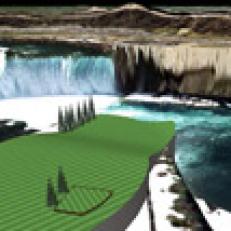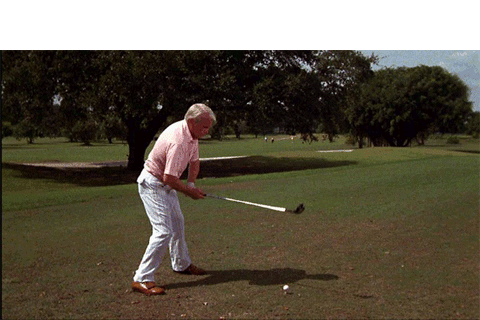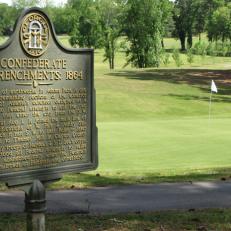The Many Intersections of Golf and the Civil War ## It's uncanny how often our Architecture Editor found aspects of golf in his study of the American Civil War
In reading Earl McElfresh's book, Maps and Mapmakers of the Civil War (Abrams 1999), I was struck by how similar the grid sketch pad used in 1863 by Union topographical engineer G.K. Warren (left) was to the grid field note pad used by course architect Donald Ross (right) Then it dawned on me that Ross surely adapted his methodology from cartography, since in essence he was mapping out golf holes.
Photo By: Stephen Szurlej
A few of the Civil War maps in McElfresh's book look eerily similar to golf holes. Compare the Civil War diagram by civilian mapmaker R.B. Talfor, of a previously uncharted area near Falmouth, Va., (left) with the Donald Ross diagram of the ninth hole at Oyster Harbor Club in Osterville, Mass. drawn 60 years later (right). Talfor even labeled his map No. 9. What a strange coincidence.
Another coincidence is how similar the Rohrbach Bridge over Antietam Creek at Sharpsburg, Md. (left) is to the Hogan Bridge over Rae's Creek on the 12th hole at Augusta National (right). Today the Rohrbach is called the Burnside Bridge, a slap-in-the-face to Union General Ambrose E. Burnside, whose troops struggled and died in attempts to control it during the Battle of Antietam, in what is said to have been the bloodiest single day of the entire war.
Freedom Hill Fort is in a very small county park in Vienna, Va., just a few blocks east of Westwood Country Club.The Union fort, said to have housed 100 Union guards, was erected in response to raids by Mosby's Rangers. To me, the earthwork looks like it could just as easily have been the remains of an old Seth Raynor or Charles Bank punchbowl green.
Photo By: Stephen Szurlej
This earthwork, along Graveyard Road on the north edge of Vicksburg National Military Park in Mississippi is not a Redan fortress, though it looks like it would make an absolutely superb Redan golf hole. Its identification sign reads, "Union trench. Matthies' — J.J. Woods' brigade." It was a staging area for some of the Union's unsuccessful assaults on the Confederate's Stockade Redan some 500 yards south of this position.
The Confederates built three Redan fortresses at Vicksburg, but only the Stockade Redan remains today. The location of the Third Louisiana Redan (partially blown up by Union forces) is designated by signs, but no park ranger or guidebook could point me to the location of the third one. Last summer, while examining the Railroad Redoubt, I noticed in the grass a small surveyor's plaque imbedded in concrete. (above) It reads in part, "Railroad Redan, 1933." So what is now called Railroad Redoubt was originally the Railroad Redan at the time to park was surveyed in 1933. I think one side of the old redan was sacrificed in order to construct the huge, elaborate Texas Monument, which was dedicated in 1961.
Until recently, this original plan of Vicksburg (Miss.) Country Club hung in its grill room (above). The course was originally called National Park Golf Club, and while it is now located outside of the Vicksburg National Military Park, when it opened in 1929 it was inside the park's boundaries. Interstate 20 now separates the park from the golf course, which is open to the public. John Van Kleek, of the Boston design firm of Stiles and Van Kleek, designed the course. Road expansion in the 1960s caused the 10th hole to be reduced from a par 4 to a par 3 and the 525-yard par-5 11th shortened to a 485 yards. Otherwise, the hilly layout is mostly as originally built, although most of the bunkers have been filled in.
Photo By: Stephen Szurlej
The Franklin (Tenn.) Golf & Country Club, south of Nashville, was closed a few years back in order that its heritage as a battlefield be reclaimed as the Eastern Flank Battlefield Park (above). I'm surprised the nine-hole course ever got built on the site in the first place.
Adjacent to the clubhouse was a Confederate Civil War cemetery.
The course is now mowed like a city park, and the cart paths will serve as walking trails once the battlefield park opens.
Another course that recently closed in order to be reclaimed as a battlefield is Gettysburg (Pa.) Country Club, positioned just down the Chambersburg Pike from McPherson Ridge, site of the first battle of the first day of Gettysburg. A creek called Willoughby Run runs along the east edge of the course, and many Confederate soldiers jumped that creek as they headed uphill to the action.
Gettysburg (Pa.) Country Club: When I visited the nine-hole course last summer, its burned-out greens and overgrown bunkers were still discernible.
When touring Gettysburg National Military Park, one can get distracted by the hundreds of commemorative monuments. I paid little attention to them, until I looked at statue atop the 72nd Pennsylvania Infantry monument and did a double-take. It looked like the soldier was swinging a golf club. I stepped a little to my left, and it became clear that the soldier was actually swinging the butt end of his rifle. That's what soldiers did when they ran out of ammunition.
From behind, the soldier depicted on the Mississippi state monument looks like a leftie with a pretty good ten-finger grip (left). Viewed from the front, it appears he had better footwork than the Pennsylvania soldier, but needed more extension to keep his right arm straighter.
On the famous Little Round Top at Gettysburg are several informational signs with paintings by artist Keith Rocco. In one, I was certain Rocco had painted (as a joke) an officer following through, only one hand on a golf club. But the sign's text corrected my delusion; the officer, a cavalry man, was pointing with his riding crop. Darn.
I conclude with something unrelated to golf, but interesting nonetheless. The 20th Maine monument celebrates the famous bayonet charge down the hillside led by Lt. Col. Joshua Chamberlain, an act that kept the Confederates from encircling the Union. (Jeff Daniels played Chamberlain in the film, Gettysburg.) I was surprised at all the trash that other tourists had left around the modest monument.
But as I got closer, I realized the snippets of paper weren't trash. They were thank-you notes to Chamberlain and his men from visitors, North and South. I was moved by the sincerity of the notes, but also amused by their existence. Who would have thought that Joshua Chamberlain would become the Jim Morrison of the Civil War?
















